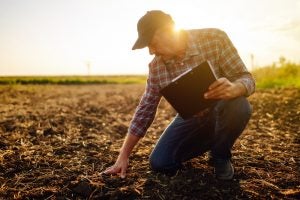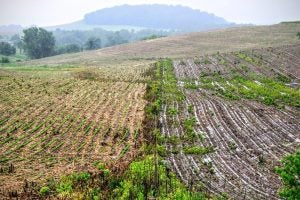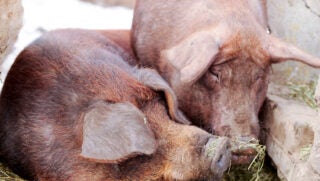Intense agricultural activity beginning in the mid-1800s has eroded the U.S. Midwest’s topsoil, the rich upper layer of soil crops need to grow. Previous work has found that erosion causes nearly $3 billion in annual losses from lower crop productivity. But if more farmers adopt more sustainable “no-till” or “low-till” practices, costly erosion could be essentially halted, a new study finds.
Erosion and soil movement occur on farms when water runs across the land, wind removes fine dirt, and plows churn up and loosen the soil. The “churning” process is called tilling. Farmers till soil to loosen soil, mix in nutrients, and help suppress weed growth. But tilling can also expose more soil to wind and water, increasing erosion.
Co-authors of the new study previously found the erosion rate since the 1800s was about 2 millimeters per year, or two orders of magnitude faster than rates in pre-settler prairies. Across the Midwestern study area, about 40 percent of farms use less intensive, more sustainable alternatives to plow-based tilling. But erosion is still a big problem.

“Two millimeters per year is a lot,” said Jeffrey Kwang, a landscape modeler at the University of Minnesota who led the study. “It sounds slow, but for landscape processes, that is very fast.” The new model used in this study predicts that soil erosion is currently occurring at about 1 millimeter (0.04 inches) per year, Kwang said, “which is still a high rate.”
The new study builds on previous work that focused on the past and present by exploring the future fate of soils in the Midwest. Kwang simulated the next century of farming in the Midwest under conventional and more sustainable tilling scenarios and predicted how topsoil erosion and carbon loss would respond. His modeling focused on physical soil movement from plowing and tilling. It did not incorporate hydrologic models, as previous research on agricultural erosion has primarily focused on water rather than plowing practices.
Under conventional tilling at the rates used today, over the next century, the Midwest would lose about 9.7 billion tons (about 8.8 billion metric tons) of soil, the researchers found, likely causing billions of dollars of losses. It would also result in a 4 percent surface soil organic carbon loss, further decreasing crop productivity. Switching to fully no-till or to low-till practices, such as strip-tilling and drill planting, would keep this from happening.
Kwang uncovered a twist: Over the next few hundred years, the rate of soil erosion might slow down. That’s because as a hill erodes, it gets flatter and erodes more slowly. But that doesn’t necessarily buy time, he said.

“The best time to do something about erosion is now,” Kwang said. “The fastest erosion rates we’re going to see are today. If we wait to change up tilling practices, we won’t get as much bang for your buck.” If we wait until the hills are flattened, a significant amount of soil will have been lost and the switch to no-till wouldn’t save as much soil, he added.
Money is a concern because the cost is one reason more farmers haven’t adopted low-intensity tilling practices, even though they might be interested in farming more sustainably. Doing so requires a new suite of expensive farming tools and time spent optimizing a new procedure. Geology plays a role, too: Northern farms tend to have dense, fine-grained soils that are more likely to need a plow, thanks to the glaciers that bulldozed the landscape during the last Ice Age.
Ample damage has already been done, Kwang said. “We’ll still have issues with crop productivity because the soils are still gone. So even if we stop erosion, sort of freezing the soils in time, we’d still need to use tactics like regenerative agriculture to try to build back that topsoil.”
Still, Kwang is optimistic. “Erosion is happening now, and we can do something about it,” he said.
The study is published in Earth’s Future, which publishes interdisciplinary research on our planet’s past, present, and future and its inhabitants.


